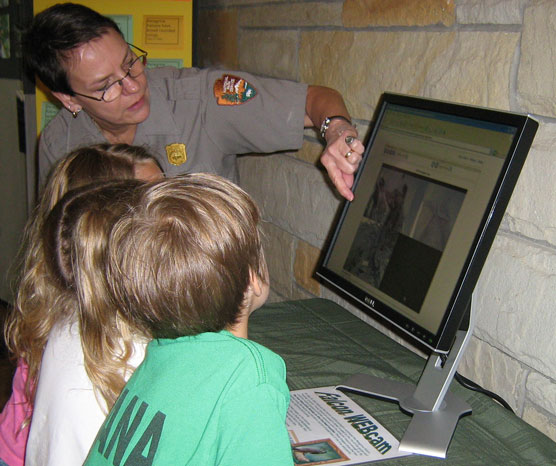|
You are viewing ARCHIVED content published online before January 20, 2025.
Please note that this content is NOT UPDATED, and links may not work. For current information,
visit https://www.nps.gov/aboutus/news/index.htm.

Contact: Matt Varner, 304 465-6542 “We just completed installation of a camera system that allows the public to see live, real-time video of the peregrine chicks in the nest box,” announced National Park Service (NPS) Superintendent, Don Striker. “During normal business hours, a monitor in the Canyon Rim Visitor Center provides continuous film coverage of the young falcons, and visitors are really enjoying it!”
“Photographs of the developing birds inside the nesting boxes are also available on the Internet at https://www.nps.gov/neri/photosmultimedia/neri_peregrine.htm. These images are updated every few minutes and are recorded by small surveillance cameras installed at various locations around the site,” explained NPS Information Technology Specialist, Greg Phillips.
One year ago, the NPS released 15 juvenile peregrine falcons at New River Gorge National River as part of a long-term restoration project. The goal of the project is the establishment of cliff- nesting peregrine falcons within the park and/or the surrounding tri-state area. Last week, the NPS shuttled eight 28-30 day old peregrine falcon nestlings from the coast of Virginia to New River Gorge. These birds were removed from two bridge nest sites where previously, young falcons have experienced high mortality levels from vehicle collisions and drowning. Once in the park, the birds were transported to the release site and placed in a large nest box, which serves as a temporary shelter for the young birds until they are able to take flight in two to three weeks.
Following the release of these eight falcons, the park expects to receive 15-20 additional young falcons over the course of the summer. “Upon release, up to 90% of these juvenile falcons will succumb to predators or other causes of mortality before reaching their breeding age of 3 years. This fact underscores the importance of releasing multiple groups of birds over the course of the next several years,” explained NPS Wildlife Biologist Matt Varner. “Although peregrine falcons feed upon other birds, we would like to clarify that these birds will not be hunting at backyard birdfeeders, because as juvenile falcons, they cannot hunt on their own for nearly a month following release and rely on feeding done by dedicated volunteers and NPS staff.” Later in the summer, the young falcons will begin hunting on their own but hunting success is generally very low and hunting success generally begins with the capture of dragonflies and other large insects. As the birds hone their skills they will be harvesting bird species including blue jays, juvenile crows, doves and pigeons in preparation for their migratory flight south to the Gulf region. For more information, Varner may be reached at 304-465-6542. |
Last updated: February 26, 2015
